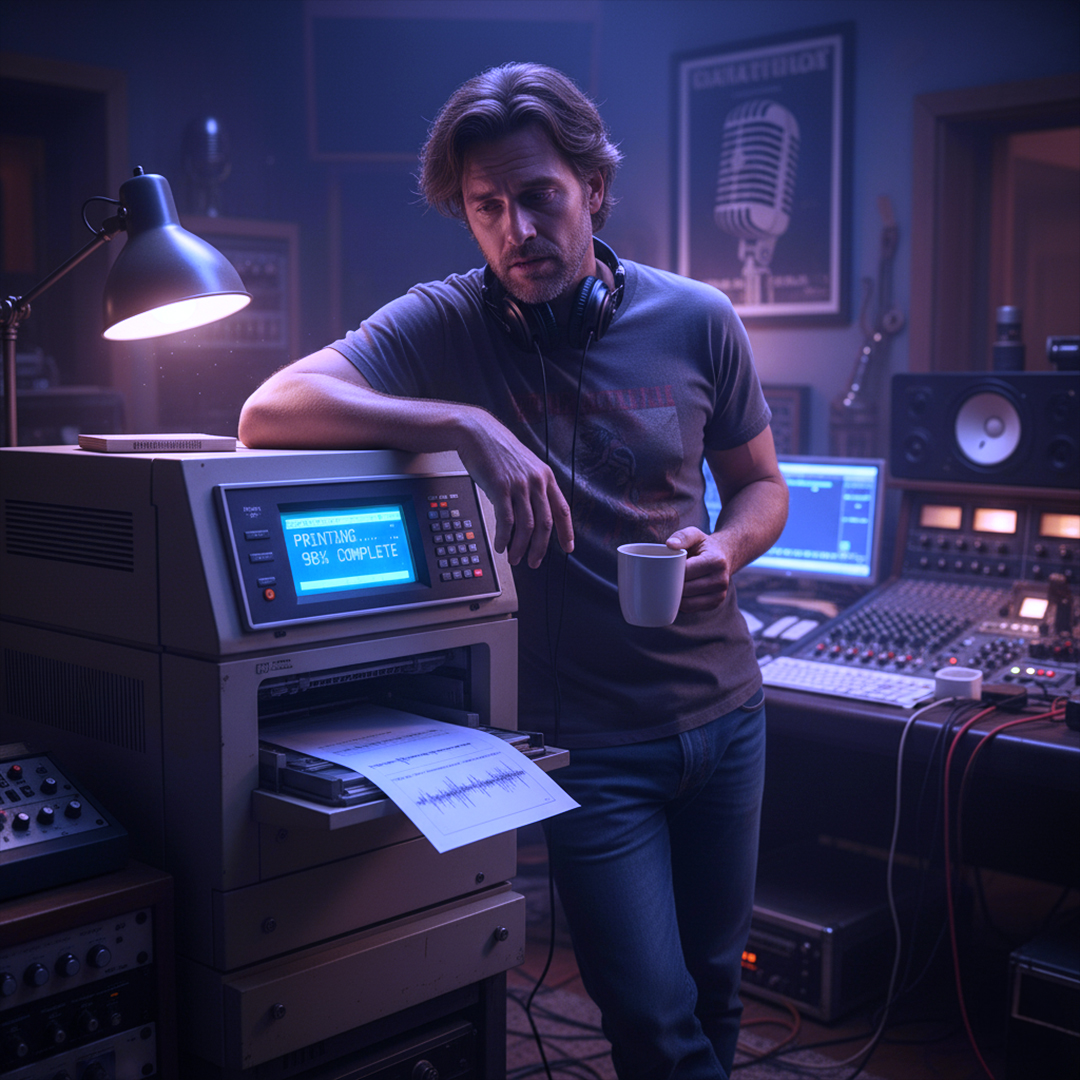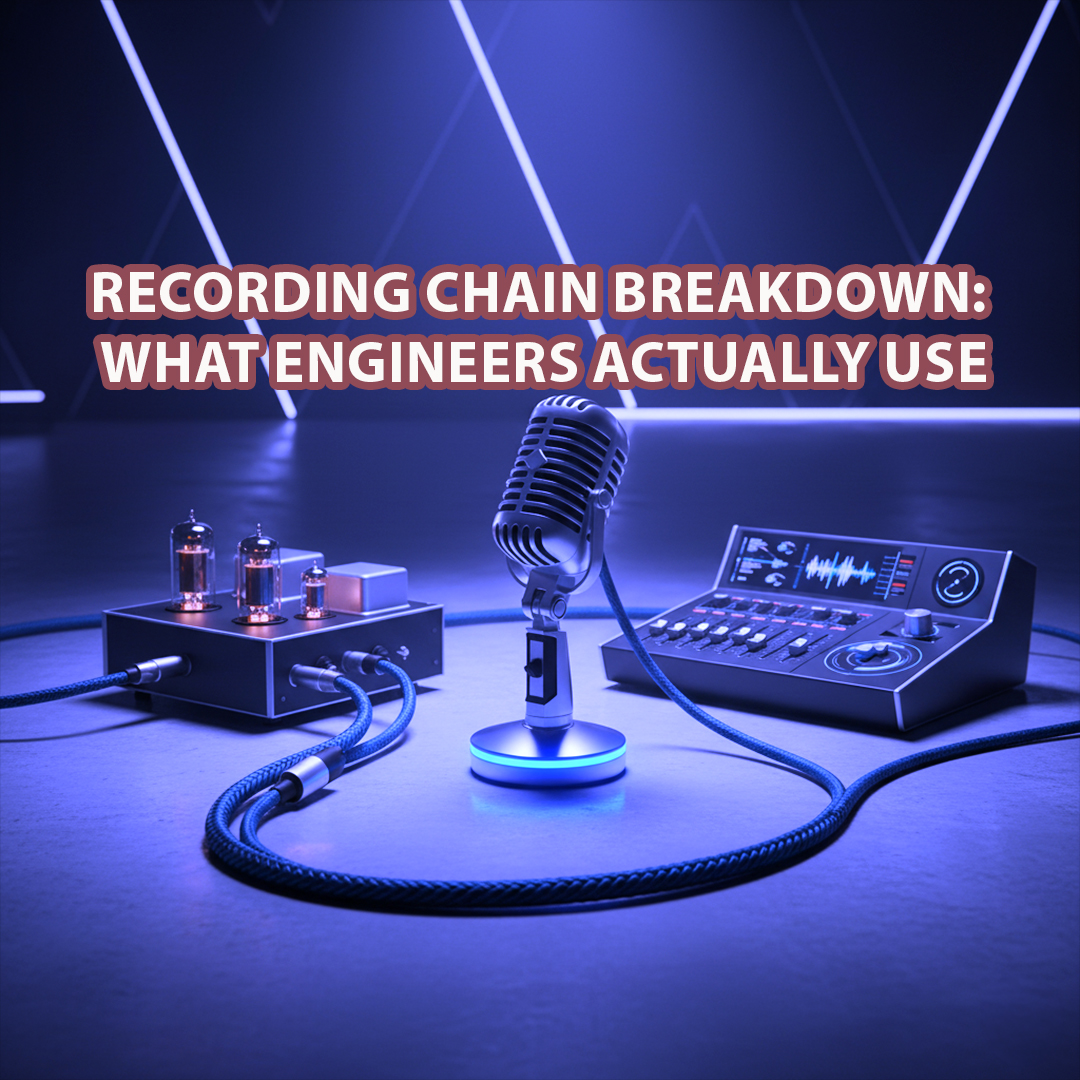If you’ve ever wondered what turns a great performance into a great record, this one’s for you. We’re walking the exact path audio travels, from capsule to converters to the final master, and highlighting the choices real engineers make at every stop. No fluff, no myths, just signal flow, best-practice guardrails, and practical gear archetypes you’ll find in studios everywhere.
 1) The Source & Mic Choice: where tone begins
1) The Source & Mic Choice: where tone begins
It starts with performance and placement. The microphone is your first “EQ,” and engineers pick models for their off-axis behavior, transient response, and proximity-effect personality.
Vocal & all-rounder staples you’ll actually see:
-
Large-diaphragm condensers for detail and air (think U87-style mics for modern vocals and VO). These are studio mainstays specifically because they deliver consistent clarity on a wide range of voices.
-
Dynamic classics (SM7B, RE20, SM57) for aggressive vocals, guitar cabs, and sources that benefit from superb rejection and controlled top end. These mics endure because they’re reliable, take EQ well, and manage plosives and room spill gracefully.
Placement beats price. Small angle changes (5–15°), distance shifts (2–10 inches), and room treatment can transform tone before you ever reach for a plugin.
2) Preamps & Front-End Tone Shaping
After the mic, a preamp brings the signal up to line level. Engineers choose:
-
Clean/transparent pres when they want the mic and room to speak (common in classical, acoustic, and high-fidelity pop).
-
Color pres (transformer or tube-based) to impart gentle saturation, low-mid weight, or forward upper mids on vocals, bass DI, or drums.
A hardware compressor or EQ on the way in is optional. Many engineers print lightly compressed vocals (1–3 dB GR) for peak control and vibe, while keeping safety headroom for mix moves later.
3) Conversion & Levels: getting into the DAW cleanly
Sample rate & bit depth: For music, 24-bit at 44.1 kHz or 48 kHz remains the practical standard; 48 kHz is often preferred for music that will also hit video. The jump to higher rates is project-dependent, but you won’t lose the plot sticking with 44.1/48 for most modern productions.
Record with headroom — don’t chase 0 dBFS. In 24-bit systems you have huge dynamic range; typical best practice is to align nominal levels well below full scale so peaks don’t clip (think peaks roughly around -10 dBFS and ~20 dB of headroom in conservative workflows). It’s common to avoid “hot” tracking and let mix bus gain-staging do the work.
Why 24-bit? Greater dynamic range and a lower quantization noise floor make conservative gain staging easy and safe.
4) Inside the DAW: editing, comping, and rough balance
Most engineers stabilize pitch and timing sparingly, then build a static mix: faders, pans, and high-value subtractive EQ to remove mud or harshness. Early in the process, many will set mix headroom (e.g., keeping the mix bus around -6 to -3 dBFS before any bus processing) so masters don’t end up fighting baked-in clipping downstream. (That headroom mindset mirrors the tracking stage.)
5) Mixing Moves That Translate
EQ: Subtractive first, then tasteful boosts with wide Q for tone.
Compression: Control dynamics and add density; parallel paths on drums and vocals remain bread-and-butter.
Saturation: Subtle harmonics help perception on smaller speakers.
Space: Short rooms/plates for presence, longer verbs or tempo-linked delays for depth — always checking mono and small-speaker translation.
Loudness vs. dynamics: Modern platforms normalize playback loudness, so chasing hyper-hot mixes is counterproductive; the streaming service will turn it down anyway. Focus on punch and transients — the normalization system adjusts gain to a target, it doesn’t “reward” squashed dynamics.
 6) Print Mixes for Mastering the Right Way
6) Print Mixes for Mastering the Right Way
Deliver a 24-bit WAV at your session rate (often 44.1 or 48 kHz), with no limiter on the mix bus (or provide a “vibe” reference plus a clean version). Mastering engineers commonly request high-resolution WAVs and, for CD manufacturing, a DDP or 16-bit/44.1 WAV deliverable. You may also consider sending in a 32-bit file with the limiter still on. This allows the mastering engineer to use this version if the stereo bus of the mix needs the limiter to maintain tonality, while allowing the mastering engineer to turn the mix file level down without losing transient information.
7) Mastering: final polish, loudness, and deliverables
Mastering engineers finesse tonal balance, control intersample peaks, and set competitive loudness while respecting dynamics. Deliverables vary by destination (download, streaming, CD, vinyl), but high-res WAVs are a modern staple; some ecosystems (e.g., Apple Digital Masters) support higher-resolution workflows via certified providers.
What This Chain Looks Like in the Real World (Typical Archetypes)
-
Indie vocal day: LDC condenser → transformer preamp → light opto compression → 24-bit/48 kHz into DAW with peaks around -10 dBFS.
-
Rock guitars: SM57-style dynamic close on cab, maybe a ribbon a foot back → blend for bite + body.
-
Podcast/rap with room issues: SM7B/RE20 near-field to kill reflections → clean preamp → gentle high-shelf in mix.
These aren’t rules; they’re starting points engineers return to because they’re predictable, musical, and fast.
Pro Tips You Can Steal Today
-
Mic first, room second, gear third. A decent mic in the right spot beats an expensive mic in the wrong room.
-
Track calmer. 24-bit lets you leave headroom; clipping is forever. 32-bit float gives you headroom and maintains transient information the best.
-
Reference early and often. Check on small speakers and in mono.
-
Mix for punch, not platform loudness. The service will normalize playback.
-
Deliver clean mixes for mastering — keep your “loud” reference separate.
From Master… to Market (without losing control)
Once your master is approved, getting it out is the final link. If you want global reach and direct sales in one place, EngineEars Direct pairs neatly with this workflow:
-
Distribute worldwide to 350+ platforms (Spotify, Apple Music, YouTube Music, Tidal, Amazon, TikTok, and more).
-
Sell direct-to-fan (digital downloads, bundles, Pay-What-You-Want) and keep 100% of your earnings.
-
Credit collaborators and set splits for automatic payouts.
-
One dashboard for analytics, delivery logs, and marketing assets (including a two-click ads manager).
It’s a clean handoff from “mic to master” → “master to market,” with ownership and transparency preserved end to end.
The Takeaway
Great records aren’t accidents. They’re the sum of dozens of smart decisions — mic choice and placement, sane gain staging, musical processing, and deliverables tailored for mastering and streaming reality. Respect the chain, and you’ll ship mixes that survive translation and masters that move people.
When you’re ready to share it with the world (and get paid for it), make sure the last leg of your chain is as dialed as the first.
